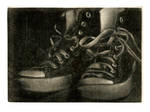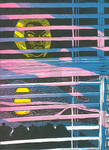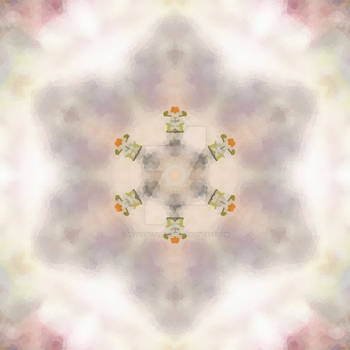ShopDreamUp AI ArtDreamUp
Deviation Actions
I would like to offer this as a feature on “Traditional Printmaking” with a view to bringing about an awareness of this lesser known, maybe somewhat neglected art form, (lesser known here at DA) and to let others know that traditional printmaking is alive here at deviantART.
Firstly I feel there is a need to clarify the difference between the terms "print" and “Traditional Printmaking” as used here at DA and possibly at other art sites around the web as well.
Prints = Any artwork or photograph that has been uploaded at a high enough resolution to be purchased in some form be it on a flat 2 dimensional surface or on a surface such as a mug or t-shirt. These are photomechanical reproductions of original artworks.
Traditional Printmaking = Artwork that has been created by transferring an impression from one object onto another two-dimensional surface. For example, as from wood with the creation of a woodblock print, from metal in the creation of an etching or from the many other inkable surfaces that can be used as a matrix for a traditional print. These are original artworks.
Printmaking is one of the oldest and most basic of art forms. Palaeontologists have found the oldest known "prints" when they discovered dinosaur foot impressions in earth that was once wet clay.
From the time of the ancient Chinese and from Dürer artists have used and developed methods of reproducing images on paper. These fine art print techniques have developed and continued to evolved over time.
Forensic scientists use the most basic of printmaking tools to help solve crimes when they take and look at human fingerprints during the course of their investigations.
One of the first pieces of art a child can do is a handprint. Left to their own devices to find their materials, their end product might not be terribly desired by mom and might result in some cleaning house, but it is creative non-the less. Finger painting comes to mind here as well. I will let you imagine all the other permutations of these early artistic endeavors.
Traditional printmaking techniques fall into four categories.
There is also Monotype – Any print or mixture of print techniques that produces a “one off” print. Some collographs may fit here as well. This whatisaprint.com/ is also useful to help understand what traditional printmaking is.
Here at DA there are listed under “Traditional Printmaking” the following print types that we can classify our submissions into.
If your having trouble finding these categories then try in the first instance looking under “Text & Typography”. For some reason someone seems to think Traditional Printmaking belongs there – maybe they equate the word "print" with “text” as in printing = writing. But anyway this is where you will find Traditional Printmaking here at DA.
To follow are some examples of the great creative work that has been and is being uploaded to this area at DA. I have tried to provide, with them some basic explanation of what each print type involves.
Collagraph – is a print taken from a collage of materials that have been clued or adhered to a supporting surface. They can be simple or very rich in texture.
Some might also classify prints done with a mixture of print types as a collagraph. These mixture prints could sometimes be classified as monotype as well possibly.




Drypoint (not dryneedle as listed) – Both this and etching could come under a broader heading of intaglio printmaking. Intaglio prints all have the image to be printed below the surface of the plate. With drypoint the lines and tones are hand-scratched into the surface of the plate with the lines and burr holding the ink. In most cases the traditional surface to do this on is metal. Zinc and copper are two of the most common metals used with a more readily available option being Perspex.



Engraving and mezzotint could also be included in this category possibly as they both are dry techniques. Engraving is crisper and cleaner than drypoint. Mezzotint involves the whole surface of the plate having a fine even texture added to it. The artist then scrapes and burnishes the surface to make varying degrees of smooth surfaces that will result in lighter shades when printed.

 Some mezzotint examples.
Some mezzotint examples.
Etching – Another print type that should be under the broader heading of intaglio printmaking. Acid and acid resistant grounds are used to create the image on the plate for this printmaking method.
:thumb57281275:


Lino – These are relief prints done from a plate that has had the image cut or gouged into it and then the raised surface is inked with the cut image being the white or lighter areas of the print. Potato prints done as a child work in the same manner, as do woodblock prints and stamps.
:thumb51132723:

Lithograph – this print form is based on the concept that grease and water don’t mix. The image is developed with materials that have an affinity to grease. Special litho pencils, crayons, wax crayons and liquid tusche are among some of the things that can be used to create the greasy image on the surface. The stone or metal with the image on it is then sponged down and inked. The ink sticks to the greasy image and is repelled by the wet areas with no image on them. The print is then taken.



Monotype – mono meaning “one” so these types of prints are one off prints. Traditionally they can be subtractive (reductive) – the surface is completely inked and ink is wiped away and then printed, or additive (direct) where the image is painted or applied directly to the surface and then printed. However any print or combination of print techniques that produces only one print impression can come into this category.


Silk Screen – This uses stencils of one form or another with a screen where the ink is forced through the stencil to reveal the image on the printed surface. Stencils can be cut or created with emulsions.



Woodblock – As with lino prints these are created with lines being cut or gouged out of the surface. These marks form the white or light areas when the plate is inked on the raised surface and then printed. Reduction prints are a process where by several layers are printed on top of each other with more cutting into the surface occurring between registrations.
:thumb44669026:


There are a few places that one can go here on DA to find and view good traditional prints. There are a couple of groups that cater to this art form. &
& 
One of the newest traditional art gallery directors has a wonderful collection of traditional prints. If you want to see just his prints then follow this browse.deviantart.com/?catpath… would also be the best person to recommend any traditional prints for a daily deviation as well.
If you want to see just his prints then follow this browse.deviantart.com/?catpath… would also be the best person to recommend any traditional prints for a daily deviation as well. 
Thank you for your time in reading this and I hope it has been of interest.
Firstly I feel there is a need to clarify the difference between the terms "print" and “Traditional Printmaking” as used here at DA and possibly at other art sites around the web as well.
Prints = Any artwork or photograph that has been uploaded at a high enough resolution to be purchased in some form be it on a flat 2 dimensional surface or on a surface such as a mug or t-shirt. These are photomechanical reproductions of original artworks.
Traditional Printmaking = Artwork that has been created by transferring an impression from one object onto another two-dimensional surface. For example, as from wood with the creation of a woodblock print, from metal in the creation of an etching or from the many other inkable surfaces that can be used as a matrix for a traditional print. These are original artworks.
Printmaking is one of the oldest and most basic of art forms. Palaeontologists have found the oldest known "prints" when they discovered dinosaur foot impressions in earth that was once wet clay.
From the time of the ancient Chinese and from Dürer artists have used and developed methods of reproducing images on paper. These fine art print techniques have developed and continued to evolved over time.
Forensic scientists use the most basic of printmaking tools to help solve crimes when they take and look at human fingerprints during the course of their investigations.
One of the first pieces of art a child can do is a handprint. Left to their own devices to find their materials, their end product might not be terribly desired by mom and might result in some cleaning house, but it is creative non-the less. Finger painting comes to mind here as well. I will let you imagine all the other permutations of these early artistic endeavors.
Traditional printmaking techniques fall into four categories.
- RELIEF – Woodcut, Linocut and some Collographs
- INTAGLIO – Etching, Drypoint, Mezzotint, Aquatint
- SERIGRAPHY – Silkscreen
- PLANOGRAPHIC – Lithography
There is also Monotype – Any print or mixture of print techniques that produces a “one off” print. Some collographs may fit here as well. This whatisaprint.com/ is also useful to help understand what traditional printmaking is.
Here at DA there are listed under “Traditional Printmaking” the following print types that we can classify our submissions into.
- Collagraph Dry Needle? – Drypoint is the correct term for this. Etching Lino Lithograph Monotype Silk Screen Woodblock
If your having trouble finding these categories then try in the first instance looking under “Text & Typography”. For some reason someone seems to think Traditional Printmaking belongs there – maybe they equate the word "print" with “text” as in printing = writing. But anyway this is where you will find Traditional Printmaking here at DA.
To follow are some examples of the great creative work that has been and is being uploaded to this area at DA. I have tried to provide, with them some basic explanation of what each print type involves.
Collagraph – is a print taken from a collage of materials that have been clued or adhered to a supporting surface. They can be simple or very rich in texture.
Some might also classify prints done with a mixture of print types as a collagraph. These mixture prints could sometimes be classified as monotype as well possibly.




Drypoint (not dryneedle as listed) – Both this and etching could come under a broader heading of intaglio printmaking. Intaglio prints all have the image to be printed below the surface of the plate. With drypoint the lines and tones are hand-scratched into the surface of the plate with the lines and burr holding the ink. In most cases the traditional surface to do this on is metal. Zinc and copper are two of the most common metals used with a more readily available option being Perspex.



Engraving and mezzotint could also be included in this category possibly as they both are dry techniques. Engraving is crisper and cleaner than drypoint. Mezzotint involves the whole surface of the plate having a fine even texture added to it. The artist then scrapes and burnishes the surface to make varying degrees of smooth surfaces that will result in lighter shades when printed.

 Some mezzotint examples.
Some mezzotint examples.Etching – Another print type that should be under the broader heading of intaglio printmaking. Acid and acid resistant grounds are used to create the image on the plate for this printmaking method.
:thumb57281275:



Lino – These are relief prints done from a plate that has had the image cut or gouged into it and then the raised surface is inked with the cut image being the white or lighter areas of the print. Potato prints done as a child work in the same manner, as do woodblock prints and stamps.
:thumb51132723:


Lithograph – this print form is based on the concept that grease and water don’t mix. The image is developed with materials that have an affinity to grease. Special litho pencils, crayons, wax crayons and liquid tusche are among some of the things that can be used to create the greasy image on the surface. The stone or metal with the image on it is then sponged down and inked. The ink sticks to the greasy image and is repelled by the wet areas with no image on them. The print is then taken.



Monotype – mono meaning “one” so these types of prints are one off prints. Traditionally they can be subtractive (reductive) – the surface is completely inked and ink is wiped away and then printed, or additive (direct) where the image is painted or applied directly to the surface and then printed. However any print or combination of print techniques that produces only one print impression can come into this category.


Silk Screen – This uses stencils of one form or another with a screen where the ink is forced through the stencil to reveal the image on the printed surface. Stencils can be cut or created with emulsions.



Woodblock – As with lino prints these are created with lines being cut or gouged out of the surface. These marks form the white or light areas when the plate is inked on the raised surface and then printed. Reduction prints are a process where by several layers are printed on top of each other with more cutting into the surface occurring between registrations.
:thumb44669026:



There are a few places that one can go here on DA to find and view good traditional prints. There are a couple of groups that cater to this art form.
One of the newest traditional art gallery directors has a wonderful collection of traditional prints.
Thank you for your time in reading this and I hope it has been of interest.
Earthquakes
The earthquake and tsunami in Japan has been horrific to watch on our tv news around the world and I really feel for the people and the country of Japan right now.
Seems however that our own earthquake disaster here in New Zealand didn't even get much of a rating here on DA. There where people here killed as well and per head of population it was probably on a par with Japan's loss
For Sinead
Just in case you do check back here Sinead.
I don't hate you ok?! I have been aware of those comments for quite a long time now and have not done anything about them.
I know you went through a bit of a rough time last year and when someone is dealing with things like that they often say things they don't mean and so that is why I had not said anything until now.
You do need to realise however that you need to watch what you say online as you never know who might see it and sometimes it can have a lasting impact on your own life or the life of others.
You didn't need to take the folio work down, just edit the comment would have been suffi
Summer of 2011
Its a long time since I have done a journal and things have all changed.
We have had a busy summer here in Kaikoura New Zealand with lots of visitors and some really hot days.
Not much time for artwork unfortunately. I had intended doing some from ideas I had during the last school year. I have however been doing some pattern drafting and learning or more correctly refreshing my memory and skills with creating patterns both new and from existing garments and I have bought some fabric to make some things. Remains to be seen however if I managed to carry this through into actually making something.
I have realised my most major fault, art
Spring Is In The Air
Warmer than usual weather
I don't know what it is but we had an early start to winter and now it seems that is flowing on into an early start to our spring here in the southern hemisphere.
The temperatures in the last couple of days have been around 10degrees higher than normal for this time of year. The spring flowers are out the blossom trees are blooming and the lambs in the paddock next door a playing. Of course there could still be a "lamb killing" storm rip through yet with it still being August and it does happen from time to time unfortuantly. The lambs next door should be fine however as its usually the newborn that don't cope w
© 2007 - 2024 HelenParkinson
Comments41
Join the community to add your comment. Already a deviant? Log In
I have always thought the term "original print" sufficed to differentiate between handpulled and photomechanical / digital "reproduction"images.
